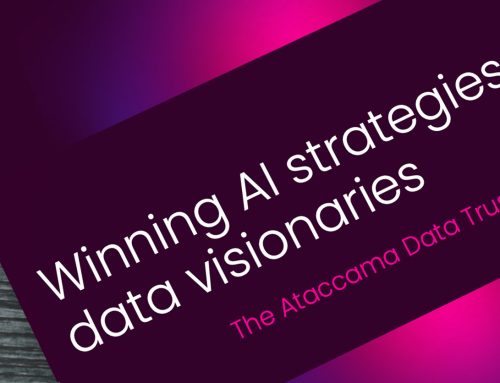The field of data management is adopting cloud-based technologies. Teams are becoming decentralized, prioritizing applications that make it easier to work collaboratively and expanding the number of users who can access and work with their data.
As a company that collects data, how important is it to keep up with trends?
In our survey, the 2022 state of data quality, we found that the two most influential factors towards data management success were also related to new trends: automation and infrastructure. Following and understanding these trends could put you on a path to attaining similar success.
Learn about all the newest trends in our article below.
Whitepaper Planning for Healthcare Data Visibility
1. Data democratization, data mesh, and data fabric
Change happens faster in the modern era. Companies need dynamic data processes that can respond and adapt to this ever-evolving environment. This need has driven companies towards a decentralized approach when organizing their data management system.
Data management can be considered “decentralized” when data is managed on a domain basis, putting more responsibility on individual departments or teams instead of a centralized body. Three terms relate to the decentralized approach: data democratization, data fabric, and data mesh.
Data Democratization. Companies that employ this philosophy hold EVERYONE in the organization responsible for the production, use, and quality of data instead of just one role or department. It focuses on providing users with more access to data, data literacy, and data culture.
Data Fabric. This data management solution design connects all data sources and data management components through metadata. Once connected, they will form a frictionless web, providing access to enterprise data to all relevant stakeholders. When fully integrated, data fabric can create a user-friendly and predominantly autonomous enterprise-wide data coverage interface.
Data Mesh. This decentralized architecture and governance concept puts responsibility for data on the teams that produce – and actually own – the data. Under this architecture, there are still some centralized governance principles to prevent data from becoming siloed.
People are moving toward a decentralized approach because:
- Decisions are more immediate, with less delay for approvals and waiting for access to data.
- It gives more power to end users.
- Creates data products that are ready to use and require no preparation.
These benefits allow decentralized approaches to be more effective at handling today’s dynamic and ever-changing data landscape. However, they also present some challenges when it comes to data management. To achieve a decentralized DM landscape, you need data management tools that can collect metadata, give data access to everyone, and combine several tools into one easy-to-use platform (so everyone can use it).
2. Data observability & AI-driven DQ
As with the entire data industry, data quality is constantly evolving. Data quality initiatives began with a rule-based approach. Later, organizations grew their use of data and started working on ruleless solutions that rely on AI/ML to find low-quality data. Now there is a new trend on the rise. It looks at data quality issue detection and resolution holistically and employs various techniques to monitor data health. It’s called data observability.
Data observability (see a workflow here) is your organization’s ability to understand the state of your data based on the information you’re collecting. It provides this understanding by monitoring your system via automation, with little manual intervention. Organizations with data observability can recognize data quality issues, anomalies, schema changes, and more about their entire data systems.
The benefits of data observability include:
- Monitoring the quality of data systems with little to no domain knowledge.
- After implementation, users can monitor the landscape and prevent issues with minimal effort.
- Proactively detect issues and notify users downstream (before the issues affect downstream systems).
- Can handle more complex data systems and recognize issues domain experts may not have thought of.
3. Modern Data stack
As approaches to data quality evolve and improve, we see similar growth in data integration. The “modern data stack” is a set of tools that saves engineering time, allows analysts and engineers to pursue higher-value activities, and has automatic scaling.
Some of the tools and features that make a data stack “modern” are:
- Cloud-based
- Automated ETL pipeline
- Cloud warehouse
- Data visualization
- Data transformation
- Offsprings: reverse ETL
The most significant difference between modern and legacy data stacks is the ease of use, making them faster, more self-service, and with a better user experience. Being cloud-native, the modern data stack has several advantages:
- Easier to integrate/onboard.
- Lower barrier to entry.
- Works well with other cloud-based applications.
- Doesn’t require technical configuration.
With the modern data stack, users can receive approachable solutions that scale with the data needs unique to your organization.
4. The rise of data & analytics governance platforms
Until now (and it’s still very true now and will be for some time), companies were forced to integrate multiple tools in their data system to serve the same purpose. You could have one vendor for your data catalog, another for data quality, and another for MDM. This presented challenges like:
- Needing to integrate multiple tools individually (very time-consuming).
- Tools not working well together.
- Everything needs to be handbuilt for your use case.
- Challenges in performance.
- Change management and user adoption.
According to Gartner, “Modern data and analytics initiatives need a balanced set of governance capabilities, but stand-alone products often do not provide what is needed.”
The data management space is already shifting towards a more comprehensive approach. Companies specializing in one area are now expanding their products to satisfy the need for tool consolidation. A BI vendor that only focused on data preparation may now include data integration and a catalog in their solutions. A governance vendor could look into expanding data quality or data observability options. Overall, individual tools are quickly becoming obsolete in favor of platforms that offer more than one functionality.
That is why, here at Ataccama, we have been focusing on building a platform that unifies data quality, metadata management, reference and master data management, a data catalog, data integration, and data visualization.
5. Cloud-native technologies and containerized applications
As mentioned in the “modern data stack” section, cloud-native data management technologies present several advantages. Because of this, cloud adoption is accelerating in all industries. Gartner’s 2021 magic quadrant found that Cloud DBMS accounted for 93% of DBMS revenue growth. They also forecast them to account for 50% of total DBMS revenue in 2022. We can link this interest and success in the cloud to four significant benefits:
- Scalability
- Low upfront costs
- Easier to use (good user experience)
- Consumption-based pricing (only pay for what you use).
Another growing trend in the data management space is using containerized applications. Containerized applications allow you to deploy (using techs like Docker or Kubernetes) an app on any hardware without needing to change the code base. They also require fewer resources to maintain.
Because of this, Gartner expects the number of organizations that have containerized apps to jump from 40% to 90% between 2021 and 2027. Moreover, they expect 25% of all enterprise apps to run in containers by 2027. Beyond their flexibility, companies are adopting containerized apps because they are more reliable, robust, and can scale.
6. Automation
Automation isn’t just happening in data quality. We can see more processes becoming automated across the entire data management industry. The primary reason? Time savings. Gartner mentioned that there is only one data engineer for every five data consumers. Resources and data engineers are scarce (especially during a recession).
Companies need out-of-the-box solutions that can automate some of their tasks. Right now, we see many processes getting automated with AI and metadata:
- Data discovery and data source onboarding
- Data quality monitoring
- Data matching and golden record creation in MDM
As companies embrace data democratization more, they will need to automate many data management processes and give simple controls to business users.
Speaking of trends that make data management more accessible…
7. Low-code/no-code data-apps
By making apps more straightforward (requiring less coding), you can make data management processes available to more users and roles. Apps such as MS Powerapps, Airtable, and Notion are excellent examples of low-code/no-code apps that almost any user can learn to use.
One practical example of a low-code data management application is Ataccama Data Observability, which lets users monitor entire data systems, such as Snowflake, without a complex setup.
Another one is ONE Data, which provides an easy way for business users to onboard data, improve data collaboratively, check its quality in an automated way, and provide that data to other applications or users — all of that in a governed environment and without taking precious data engineer time.
Beyond that, organizations are also creating localized apps of their own with simple workflows. Localized apps can lead to localized databases that can manage minor local problems. Of course, this is a major benefit to decentralized organizations because they can utilize tools on a team-by-team basis, prioritizing the preferences of individual users.
Conclusion
All of these advancements and updates are undoubtedly exciting, but how do you join the movement? At Ataccama, we are focused on building a unified, automated data management platform that democratizes data and fuels business innovation. We encourage you to review our free tools or book a meeting to discuss your needs.
Bron: https://www.ataccama.com/blog/7-data-management-trends




